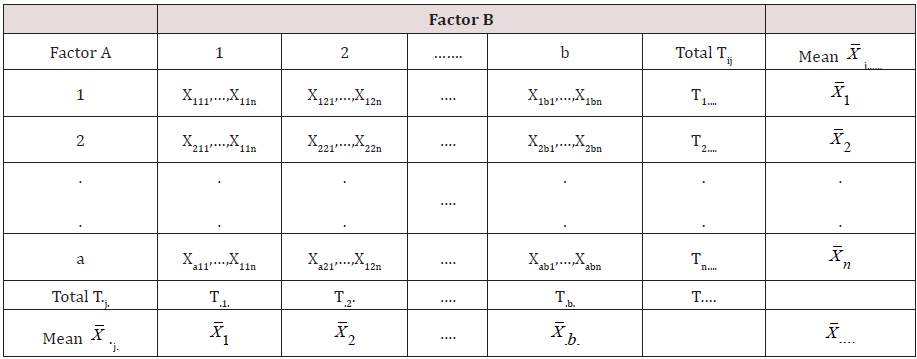
Lupine Publishers Group
Lupine Publishers
Menu
ISSN: 2644-1381
Research Article(ISSN: 2644-1381) 
Effect of Groundnut Cake and Water on Weight of Pigs (Randomized Block Design) Volume 2 - Issue 5
Matthew Chukwuma Michael*, Ashinze Mkpuruoma Akudo and Nwabenu Christian Dominic
- Department of Mathematics and Statistics, Delta State Polytechnic, Ogwashi, Uku
Received: June 11, 2020; Published: June 26, 2020
*Corresponding author: Matthew Chukwuma Michael, Department of Mathematics and Statistics, Delta State Polytechnic, Ogwashi, Uku
DOI: 10.32474/CTBB.2020.02.000148
Abstract
This study aimed at determining the effect of groundnut cake and water on the weight of pigs. To that effect, it seek to develop the generalized linear model for the treatment effects and interaction as well as test their significance. Using a randomized complete block design, data were collected from sixty-four randomly selected pigs in a farm selected for the study. The generalized linear model was successfully fitted and the significance of the treatments tested. It was observed that the groundnut cake and water levels considered did not have significant effects. However, the pigs’ weight changed significantly suggesting that there exist other factors that contributed to the weight change.
Introduction
Meat is particularly consumed to nourish the body with essential proteins and amino acids. However a classification of meat, red meat, is believed to contain low density lipids which increase the harmful cholesterol level in man. White meat on the other hand is believed to contain little or no amount of the lipids and are seen to be better for good health. Mammals are the world’s major sources of red meat. Pig is the only mammal known to bear very small or no amount of cholesterol. It also very cheap in the market.
However, people resent pig meat because pig was seen as very dirty animal known to wallow in dirty water. The consumption of pig meat is forbidden in certain religions like Islam and Judaism not minding its high protein, vitamins and minerals composition [1] Pigs are amenable to many different styles of farming; intensive commercial units, commercial free range enterprise and extensive farming. They were valued as a source of meat, fat and for the ability to turn inedible food into meat [2]. A good number of cosmetics are made of pig biomass and pigs are also of much significance for medical use [3]. Nutrition and feed management are very important aspects of pig production because pigs of different breeds and genetics have different capabilities for production and different nutrients requirement [4]. Growth rate and efficiency of feed conversion has been found to improve with dietary protein level, pigs consuming blood meal diets are most efficient on twenty percent crude protein level and at equivalent levels of crude proteins, pigs consuming blood meal supplemented diets perform better than those consuming diet without blood meals [5]. In search of a more optimal profit in pig production, improvised feed are used as substitutes for industrial commercial sources which are scarce, expensive, produced for general consumption and may not meet the peculiarity of individual farms. Groundnut cake is a common improvisation of protein in piggery and its effects at various water levels are yet to ascertained with a randomized complete block design.
Methodology
The major aim of this study is to develop a model for the relationship between pig weight, amount of groundnut cake consumed, volume of water consumed and the interaction of both. The specific objectives, therefore, include: to collect data on weight change in pigs for the random block design; to set up an ANOVA model for the relationship of groundnut cake, water levels and their interaction and; to test the significance of the effect of groundnut cake, water levels and their interaction on pig weight. Thus, the study will be significant in providing a statistical solution for the effects of groundnut cake, water and their interaction on the weight of pigs. A total of 64 pigs of the same breed and the same age were randomly selected from 823 pigs in the selected farm. Four pigs were randomly selected foe each of sixteen separate pens. Four levels of groundnut cake namely 5kg, 10kg, 15kg and 20kg were cross classified with four levels of water namely 8 liters, 12 liters, 16 liters and 20 liters. Each pen was treated with a specific combination of groundnut cake and water level. The pigs were exposed to the treatments for a period of two weeks. At the end of the period, each pig was weighed to ascertain its change in weight as compared to their initial weight observed at the commencement of the experiment and the resulting change in weight was recorded for the 64 pigs considered in the study. The major assumptions of the study are that the pigs under study were of the same age, all hereditary factors are constant and other food nutrient do not interfere with the experiment. The analytical technique applied is the Two-Way Analysis of Variance with Interaction while the analytical software is MINITAB 17. The Two-Way ANOVA makes it possible to ascertain the proportion of the total variation attributable to each source of variation in a data set. It does not require making any assumptions about the nature of the statistical relations between the dependent and the independent variables [6]. Since all combinations of groundnut cake and water are considered in the experiment, the model is then, a fixed effect model. Hence,
Xijk = μ…+αi +βj +αβij + eijk (1)
where μ_… is a constant, α_i is a constant representing the mean
effect due to the i^th level of Factor A and subject to the constraint
 is a constant representing the mean effect of j^th
level of Factor B and subject to
is a constant representing the mean effect of j^th
level of Factor B and subject to  is also a constant
representing the interaction effect between the i^th level of Factor
A and the j^th level of Factor B and subject to
is also a constant
representing the interaction effect between the i^th level of Factor
A and the j^th level of Factor B and subject to  and
eijk are independently and normally distributed error terms with
mean, 0, and variance, σ^2. Under the specifications of Equation 1,
the Xijk are still independently and normally distributed with mean,
μijk = μ.... +αi + βj +αβij and variance, σ^2. This means that each
of the n observations in each of the ab treatment combinations is
independently and normally distributed with a mean that depends
on the treatment combinations and with a common variance.
The null hypotheses, H_0, are stated as follows:
and
eijk are independently and normally distributed error terms with
mean, 0, and variance, σ^2. Under the specifications of Equation 1,
the Xijk are still independently and normally distributed with mean,
μijk = μ.... +αi + βj +αβij and variance, σ^2. This means that each
of the n observations in each of the ab treatment combinations is
independently and normally distributed with a mean that depends
on the treatment combinations and with a common variance.
The null hypotheses, H_0, are stated as follows:

A typical Two-Way ANOVA Table1 is shown below.
Xijk is the Kth observation for the i^th level of Factor A and the j^th level of Factor B. K = 1, 2,..., n; i = 1, 2,...,α ; j = 1, 2,...., b;
 total of all the observations for the ith
level of Factor A;
total of all the observations for the ith
level of Factor A;
 mean of observations for the ith level of Factor A;
mean of observations for the ith level of Factor A;
 total of all observations for the jth level
of Factor B;
total of all observations for the jth level
of Factor B;

Hence,

Data Presentation Analysis
The data for this study are presented in Table 2 below. Factor A represents the amount of groundnut cake in kilograms consumed by the pigs while Factor B represents the amount of water in liters consumed by the pigs. The Equation:
Weight change

The generalized linear model has an R-squared value of 18.40%; the constant term has a P-value of 0.000; groundnut cake has a P-value of 0.056; water has a P-value of 0.198 and interaction has a P-value of 0.197.
Conclusion
The following conclusions can be drawn from the study: the generalized linear model was successfully fitted for the effect of groundnut cake and water on weight change in pig; the intercept for the model is significant; factors A and B did not show any significance; 18.40% of the total variation in weight change was accounted for by the generalized linear model; there may be other levels of the factors that contributed to weight change and; here may be other factors that affect weight change [7].
Recommendations
Due to the significance of the intercept, it is obvious that even if groundnut cake and water were kept constant, the weight of the pigs would increase by 2.357kg. Hence, it is recommended that the other nutrients/ingredients in the pig feed should be maintained at their optimum levels. Also, other levels of groundnut cake and water should be studied and; other factors should studied to ascertain the actual factors contributing to weight change in the pig feed.
References
- Arnarson A (2015) Pork 101 Nutrition Facts and Health Effects Canada: Healthline Supports.
- Flisser A, Hanaba R, Praet N, Carabin H, Millogo A, (2011) Factors Associated with Prevalence of Circulating Antigens to Porcine Cysticerasis in Villages of Burkina Faso. Plos Neglected Tropical Diseases 5(1): e927.
- Info C (2017) Pig in Cosmetics.
- Gerhard P (2017) Factors Influencing Nutrient Requirements in Pigs. South African Pork Producers Organization.
- Balogun TF (1982) The Effect of Dietary Protein Level and Blood Meal Supplementation on the Performnace of Growing Large White and Landrace Pigs in Nigeria. Tropical Animal Production 7: 14-19.
- Oyeka IC (2013) An Introduction to Applied Statistical Methods (Ninth ed ) EnugunNigeria: Nobern Avocation Publishing Company.
- Purdue edu (2017) Pig in Medicine.

Top Editors
-

Mark E Smith
Bio chemistry
University of Texas Medical Branch, USA -

Lawrence A Presley
Department of Criminal Justice
Liberty University, USA -

Thomas W Miller
Department of Psychiatry
University of Kentucky, USA -

Gjumrakch Aliev
Department of Medicine
Gally International Biomedical Research & Consulting LLC, USA -

Christopher Bryant
Department of Urbanisation and Agricultural
Montreal university, USA -

Robert William Frare
Oral & Maxillofacial Pathology
New York University, USA -

Rudolph Modesto Navari
Gastroenterology and Hepatology
University of Alabama, UK -

Andrew Hague
Department of Medicine
Universities of Bradford, UK -

George Gregory Buttigieg
Maltese College of Obstetrics and Gynaecology, Europe -

Chen-Hsiung Yeh
Oncology
Circulogene Theranostics, England -
.png)
Emilio Bucio-Carrillo
Radiation Chemistry
National University of Mexico, USA -
.jpg)
Casey J Grenier
Analytical Chemistry
Wentworth Institute of Technology, USA -
Hany Atalah
Minimally Invasive Surgery
Mercer University school of Medicine, USA -

Abu-Hussein Muhamad
Pediatric Dentistry
University of Athens , Greece

The annual scholar awards from Lupine Publishers honor a selected number Read More...






